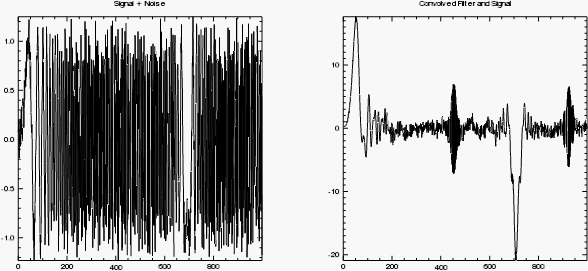BLK_CON
The BLK_CON function computes a “fast convolution” of a digital signal and an impulse-response sequence. It returns the filtered signal.
This routine is written in the IDL language. Its source code can be found in the file blk_con.pro in the lib subdirectory of the IDL distribution.
Example

The following lines create the plot shown at the top of this topic:
; Create a filter of length P = 32
filter = REPLICATE(1.0 ,32) ;Set all points to 1.0
filter(2*INDGEN(16)) = 0.5 ;Set even points to 0.5
; Create a sampled signal with random noise
signal = SIN((FINDGEN(1000)/35.0)^2.5)
noise = (RANDOMU(SEED,1000)-.5)/2.
signal = signal + noise
; Convolve the filter and signal using block convolution
result = BLK_CON(filter, signal)
plot1 = PLOT(signal, TITLE='Signal + Noise', $
DIMENSIONS=[960,480], LAYOUT=[2,1,1])
plot2 = PLOT(result, TITLE='Convolved Filter and Signal', $
LAYOUT=[2,1,2], /CURRENT)
Syntax
Result = BLK_CON( Filter, Signal [, B_LENGTH=scalar] [, /DOUBLE] )
Return Value
This function returns a vector with the same length as Signal. If either of the input arguments are double-precision or the DOUBLE keyword is set, the result is double-precision, otherwise the result is single-precision.
Arguments
Filter
A P-element floating-point vector containing the impulse-response sequence of the digital filter.
Signal
An n-element floating-point vector containing the discrete signal samples.
Keywords
B_LENGTH
A scalar specifying the block length of the subdivided signal segments. If this parameter is not specified, a near-optimal value is chosen by the algorithm based upon the length P of the impulse-response sequence. If P is a value less than 11 or greater than 377, then B_LENGTH must be specified.
B_LENGTH must be greater than the filter length, P, and less than the number of signal samples.
DOUBLE
Set this keyword to force the computation to be done using double-precision arithmetic.
Version History
|
Pre 4.0 |
Introduced |